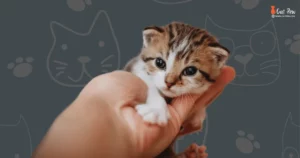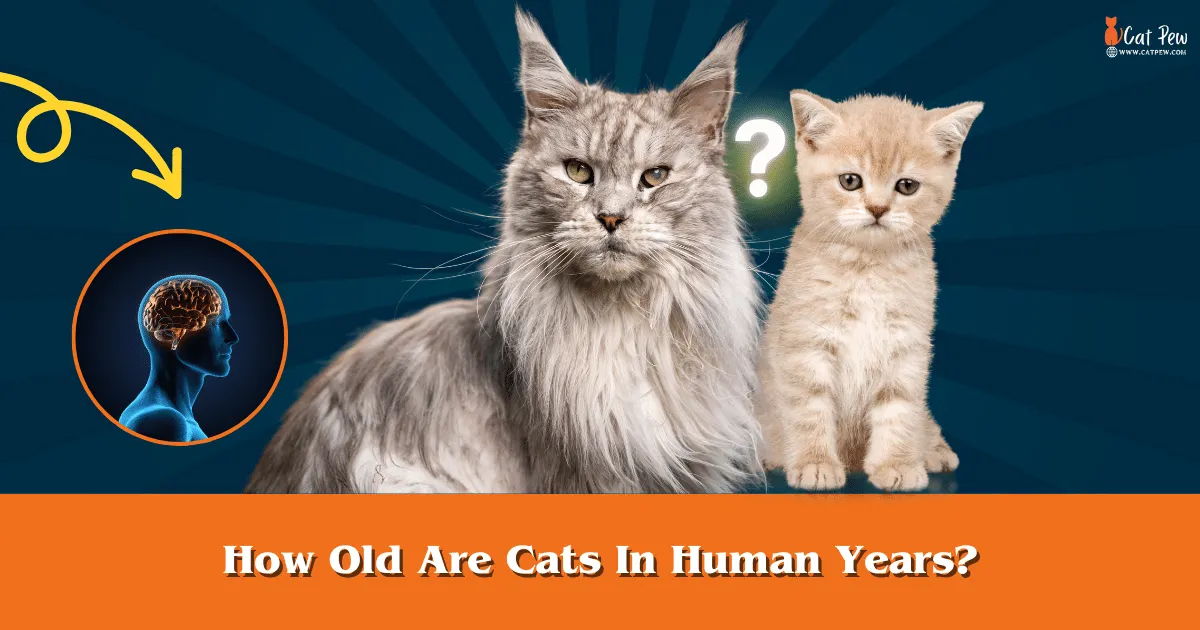How Old Are Cats In Human Years?
Cats age differently than humans, so it’s not accurate to simply convert their age to human years. However, as a general guideline, a cat’s first year is roughly equal to 15 human years, and each additional year is about 4 human years.
In other words, a 10-year-old cat would be approximately 53 in human years. Cats hold a particular charm as pets, but understanding their age about human years can sometimes be challenging. While it’s not an exact science, there are general guidelines to help you estimate their human age equivalents.
This article will shed light on the question, “How old are cats in human years? ” By providing a reliable conversion, it aims to simplify the understanding of feline aging and strengthen the bond between cats and their owners. So grab a cup of tea and let’s delve into the fascinating world of cat years!
1. Understanding Cat Aging

As pet owners, it’s natural for us to be curious about how old our feline friends are in human years. After all, it helps us better understand their needs and how to provide appropriate care as they mature. While the common belief that one cat year equals seven human years has been widely circulated, the reality is a bit more complex. In this article, we’ll delve into the factors that impact cat aging and the aging process in cats.
1.1 The Myth Of One Cat Year Equals Seven Human Years
Contrary to popular belief, the notion that one cat year is equivalent to seven human years isn’t entirely accurate. This ratio may have stemmed from a simple calculation taking into account the average lifespan of cats and humans. However, the truth is that cats age differently at different stages of their lives. In their first year, cats grow and develop at a rapid pace, and their maturation process is more akin to that of a human child. As they get older, though, the aging process slows down, resulting in a different ratio.
1.2 Factors That Impact Cat Aging
Several factors influence how cats age. The most significant factor is genetics. Just as genetics play a crucial role in determining how humans age, the same is true for our feline companions. Cats with a genetic predisposition to certain diseases or health conditions may experience age-related issues earlier or more severely than others.
Another factor that impacts cat aging is their lifestyle and overall health. Just like how humans who exercise regularly and maintain a balanced diet tend to age more gracefully, cats who receive proper nutrition and engage in regular exercise are more likely to experience a slower aging process. Additionally, access to appropriate veterinary care, vaccinations, and regular check-ups can also contribute to their overall health and longevity.
1.3 Aging Process In Cats
The aging process in cats can be categorized into different stages, each marked by specific changes in their physical and mental capabilities. The following table provides a breakdown of the aging process in cats:
| Age | Percentage of Lifespan | Signs of Aging |
|---|---|---|
| 1-6 years | 10-40% | Physical and sexual maturity |
| 7-10 years | 50% | Early signs of aging, decreased activity |
| 11-14 years | 60-70% | Moderate aging, potential health issues |
| 15+ years | 80%+ | Advanced aging, increased vulnerability to diseases |
Cat owners must be aware of these stages so they can provide appropriate care and support as their feline companions age. Regular veterinary check-ups are essential for monitoring their health and detecting any age-related issues early on.
2. Converting Cat Age To Human Years

If you’ve ever wondered how old your beloved feline friend is in human years, you’re not alone. Understanding a cat’s age in human terms can give us a better perspective on their life stages and help us provide appropriate care for them. So, let’s dive into the fascinating world of converting cat age to human years.
2.1 Human Age Equivalent For The First Year Of A Cat’s Life
A cat’s first year of life is a whirlwind of growth and development. In this short span, they experience significant changes comparable to the early stages of human development. It’s essential to know the human age equivalent to better appreciate their development. Here’s a breakdown:
| Cat Years | Human Years |
|---|---|
| 0-1 month | 0-1 year |
| 2-3 months | 2-4 years |
| 4-5 months | 5-6 years |
| 6-8 months | 10 years |
| 1 year | 15 years |
| 2 years | 24 years |
This table roughly shows the human years equivalent to the first year of a cat’s life. You can see that during the first couple of months, a kitten grows at an astounding rate, similar to how a human baby develops in their first year. By the time they reach their first birthday, a cat is considered to be around 15 years old.
2.2 Human Age Equivalent For The Second Year And Beyond
Once a cat reaches their second year, their growth slows down compared to their first-year milestones. However, they continue to mature and age gracefully. To give you an idea of the human age equivalent during this period:
- 2 years old = 24 years old in human years
- 4 years old = 32 years old in human years
- 6 years old = 40 years old in human years
- 8 years old = 48 years old in human years
- 10 years old = 56 years old in human years
- 12 years old = 64 years old in human years
It’s interesting to see that cats age more rapidly in their early years but start to experience slower aging as they reach adulthood. It’s crucial to bear in mind that these age equivalents are an estimation and can vary slightly depending on breed, genetics, and overall health.
2.3 Comparison Of Cat Age With Human Age
Now that we have an understanding of how cat age converts into human years, let’s compare the two. Take a look at the following chart:
| Cat Age | Human Age Equivalent |
|---|---|
| 1 year | 15 years |
| 2 years | 24 years |
| 4 years | 32 years |
| 6 years | 40 years |
| 8 years | 48 years |
This comparison highlights how a cat’s age correlates with human age. As cats age, they tend to slow down physically, just like humans. It’s essential to monitor their health, provide proper nutrition, and schedule regular veterinary check-ups to ensure they age gracefully.
Hopefully, this breakdown of converting cat age to human years has given you a better understanding of where your feline companion stands in their life journey. By knowing their age in human terms, you can ensure they receive age-appropriate care and provide them with the love they deserve at every stage of their lives.
3. Common Misconceptions

When it comes to understanding the age of cats about human years, several common misconceptions can confuse even the most informed cat owner. It’s important to dispel these myths and gain a clear understanding of how cats age. In this section, we will address three key misconceptions: different cat breeds and aging, health considerations about cat age, and the role of lifestyle in cat aging.
3.1 Different Cat Breeds And Aging
Contrary to popular belief, different cat breeds do not age at different rates when compared to human years. While it’s true that some cat breeds may have longer lifespans than others, the process of aging remains consistent across all breeds. Just like humans, cats go through distinct life stages, starting as kittens and gradually transitioning into adults and seniors. However, the specific lifespan of a cat can vary depending on various factors such as genetics, diet, and overall health.
3.2 Health Considerations About Cat Age
Another common misconception is that a cat’s age directly corresponds to their level of health. While it’s true that older cats may be more prone to certain health issues, such as arthritis or dental problems, age alone does not determine the overall health of a cat. Factors such as genetics, diet, exercise, and regular veterinary care play significant roles in a cat’s overall well-being. Cat owners must provide appropriate preventive care and monitor their cat’s health regardless of their age.
3.3 The Role Of Lifestyle In Cat Aging
Many people believe that cats age in a fixed and linear manner, but lifestyle factors can influence their rate of aging. Cats that lead a sedentary lifestyle, lack mental stimulation or have poor-quality diets may experience a faster decline in health and vitality as they age. On the other hand, cats that maintain an active lifestyle, receive proper nutrition and engage in mental and physical activities can age more gracefully. Providing a stimulating and enriched environment for your cat can help promote their overall well-being and potentially extend their lifespan.
4. Life Stages And Age Milestones

Cats go through several distinct life stages, each bringing its unique milestones and experiences. Understanding these stages can help you anticipate and meet your feline friend’s changing needs as they age. From the playful energy of kittenhood to the wisdom and grace of their senior years, every stage holds its charm.
4.1 Kittenhood (birth To 6 Months)
Kittens are adorable bundles of fur and curiosity. During this stage, they grow rapidly and develop their motor skills. Their sense of adventure is unmatched, as they explore their surroundings and play with everything in sight. It’s important to provide them with a safe and stimulating environment to foster their cognitive and physical development.
4.2 Junior (7 Months To 2 Years)
In the junior stage, cats start to mature physically and mentally. They become more independent and may establish their territory. This is also the ideal time for socialization and training. Engaging them in interactive play sessions helps keep their minds sharp and their energy well-channeled. It’s a great idea to introduce them to new experiences and stimuli during this stage.
4.3 Prime (3 To 6 Years)
From 3 to 6 years of age, cats enter their prime years. They display a healthy balance between youthful energy and mature independence. These years are often characterized by a stable routine and a deeper bond with their human companions. Regular check-ups with your veterinarian are crucial during this stage to maintain their overall health and detect any potential issues early on.
4.4 Mature (7 To 10 Years)
As cats reach the mature stage, they may start to show signs of slowing down. Their activity levels might decrease, and they may become more selective in their preferences. Maintaining a healthy diet and providing opportunities for gentle exercise can help maintain their muscle tone and weight. It’s important to keep an eye out for any age-related conditions such as arthritis, dental problems, or changes in appetite.
4.5 Senior (11 To 14 Years)
In their senior years, cats may exhibit more significant changes in behavior and health. It’s essential to provide them with a comfortable and stress-free environment. Regular veterinary visits become even more critical, allowing for early detection and management of age-related conditions. Taking extra care with their diet, exercise, and overall well-being can help ensure their golden years are happy and enjoyable.
4.5 Geriatric (15 Years And Older)
Once cats reach 15 years and older, they are considered geriatric. At this stage, they may require extra attention and specialized care. Their mobility might be reduced, and they may benefit from softer bedding and easier access to food and water. Regular check-ups and screenings become even more important to monitor their health closely. Providing them with a calm and low-stress environment is key to their comfort and quality of life.
Conclusion Of How Old Are Cats In Human Years
Understanding the age of your cat in human years is essential for their overall care and well-being. By applying the 1:7 ratio, you can estimate their age and adjust their lifestyle accordingly. Whether you have a playful kitten or a mature feline companion, knowing their age in human years enables you to make informed decisions regarding their diets, exercise, and healthcare needs.
Take the time to assess your cat’s age and provide them with the love and care they deserve at every stage of their life.
Frequently Asked Questions For How Old Are Cats In Human Years?
How Do I Calculate The Age Of My Cat In Human Years?
The common belief that one cat year is equivalent to seven human years is a misconception. The American Association of Feline Practitioners provides a more accurate conversion. For the first two cat years, each is approximately equivalent to 12 human years. After that, each additional cat year is around four human years.
Do Different Cat Breeds Age At The Same Rate In Human Years?
No, the aging process can vary among breeds. Some larger breeds may age more rapidly than smaller ones. It’s essential to consider a cat’s health and genetics when estimating its age.
How Can I Help My Cat Age Gracefully?
Regular veterinary check-ups, a balanced diet, proper exercise, and a stimulating environment can contribute to a cat’s overall well-being. Providing a comfortable and safe space for your cat will also support healthy aging.
Are There Signs That Indicate My Cat Is Entering Its Senior Years?
Behavioral changes, decreased activity, changes in appetite, and alterations in grooming habits can be indicative of a cat entering its senior years. However, these signs can vary, and consulting with a veterinarian is advisable for a comprehensive
How Old Is A 7 Year Old Cat In Human Years?
A 7-year-old cat is equivalent to around 44 human years.
How Old Is A 10 Month Old Cat In Human Years?
A 10-month-old cat is equivalent to approximately 6-7 years in human years.
How Old Is 2 Years In Cat Years?
A 2-year-old cat is approximately 24 years old in human years.
How Old Is 15 In Cat Years?
A 15-year-old cat is approximately 76 in cat years old.

Jonathon
I love cats, I have more than 10 years of experience in raising cats. I want to share with everyone useful knowledge about cats.

